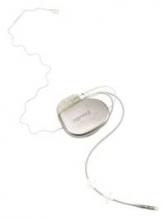SILVER SPRING, MD. – A surgically implanted upper airway stimulation device is a step closer to earning approval as a treatment for adults with refractory moderate to severe obstructive sleep apnea who have failed or cannot tolerate continuous positive airway pressure.
At a meeting on Feb. 20, the Food and Drug Administration’s Anesthesiology and Respiratory Therapy Devices Panel supported approval of the Inspire Upper Airway Stimulation System, voting 12 to 0, with one abstention, that the benefits of the device outweighed its risks as a treatment for adults with moderate to severe obstructive sleep apnea (OSA) who have failed or cannot tolerate continuous positive airway pressure (CPAP) "and who have absence of complete concentric collapse at the level of the soft palate," the indication under FDA review.
The components of the device are a stimulation lead placed around the distal hypoglossal nerve, a pulse generator implanted subcutaneously below the clavicle in the upper chest, and a respiration sensing lead inserted between the fourth and fifth ribs – implanted under general anesthesia, with three surgical incisions. External components include patient and physician programmers. Stimulation of the hypoglossal nerve during the inspiration phase of respiration "results in a forward movement of the base of the tongue, which in turn prevents airway collapse," according to the manufacturer, Inspire Medical Systems.
Panelists had concerns about some safety issues and how the device would be used in practice. But overall, they were enthusiastic about the potential for the device and agreed that the pivotal study, the STAR (Stimulation Therapy for Apnea Reduction) trial, was well done, and had "compelling" results.
The data provided "fairly strong evidence that this is a reasonably safe and effective treatment," said panelist Dr. Andrew Ries, director of the pulmonary rehabilitation program and professor of medicine and family preventive medicine at the University of California, San Diego. There are unanswered questions about how it will be used in the real world, "but it appears to be an important innovative technique," he added.
Panelist Dr. Henry Klar Yaggi of the department of pulmonary, critical care, and sleep medicine, Yale University, New Haven, Conn., said that the patients in the study represent "an underserved population of patients who have an opportunity to benefit" from this therapy.
STAR, a prospective single-arm study, evaluated the device in 126 mostly male, white patients, whose mean age was about 55 years, and who had moderate to severe OSA and had either failed or were intolerant of CPAP. Patients with a BMI greater than 32 kg/m2 were excluded. Only two patients did not complete the study and were considered nonresponders. The apnea-hypopnea index (AHI), the number of apnea or hypopnea events per hour, and the oxygen desaturation index (ODI), the number of times per hour of sleep that blood oxygen levels dropped by at least 4 percentage points from baseline, were the two main outcome measures.
The median AHI score dropped from 29.3 events per hour at baseline to 9 events per hour at 12 months, a 68% reduction that was highly statistically significant (15 or higher indicates moderate to severe apnea). Median ODI scores dropped from 25.4 events per hour at baseline to 7.4 events per hour at 12 months, a 70% reduction that was also highly statistically significant. All five secondary efficacy endpoints – including improvements in a daytime sleepiness scale and the percentage of sleep time with an oxygen saturation level below 90% – were also statistically significant (N. Engl. J. Med. 2014;370:139-49).
The rate of serious adverse events related to the procedure was under 2% (two cases where the neurostimulator had to be repositioned). Nonserious device-related adverse events included 35 cases of tongue weakness in 23 patients; most (27) resolved with no interventions. The three deaths were not considered to be related to the device. Other adverse events included stimulation-related discomfort (99 events in 59 patients) and tongue abrasions or irritation (38 events in 30 patients).
Issues raised by FDA reviewers included the multiple titrations many patients needed to achieve a therapeutic effect of stimulation or to address stimulation-related discomfort, and the possibility that patients might skip CPAP in favor of this device. But the panel agreed that when the multiple amount of titrations needed was considered, the data showed a durable effect for a period of time that they thought was clinically meaningful, and that it would be an advantage to be able to titrate the stimulation.


